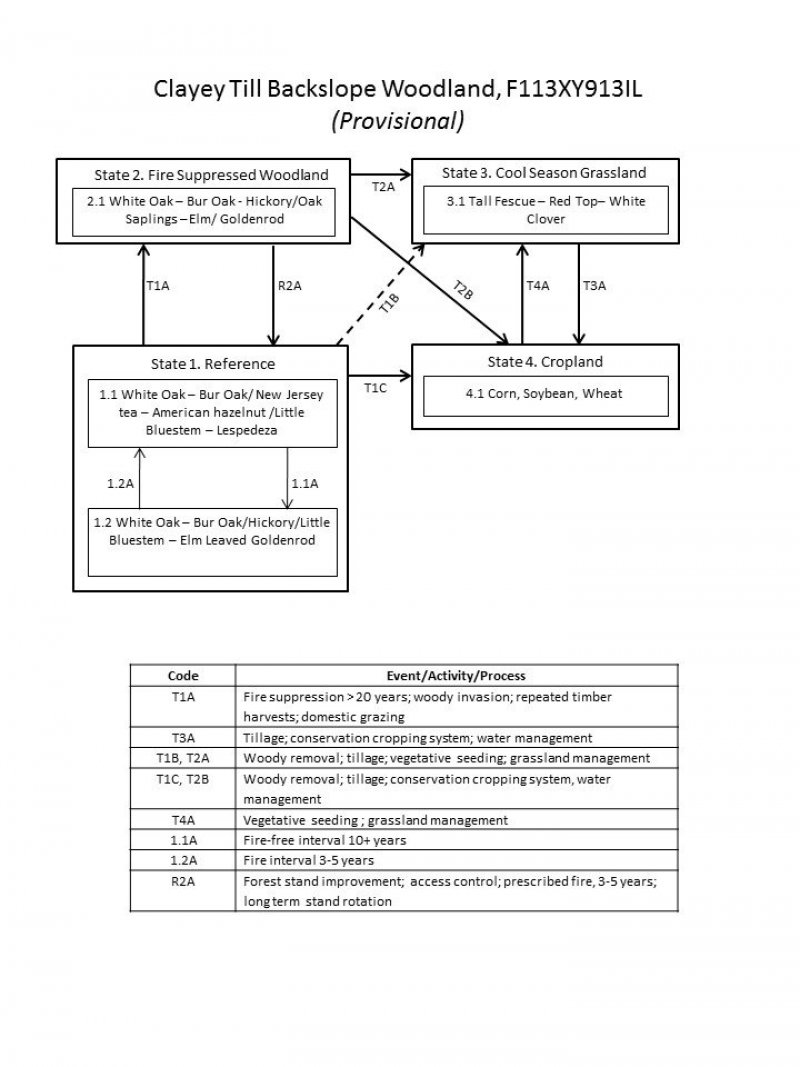
Natural Resources
Conservation Service
Ecological site F113XY913IL
Clayey Till Backslope Woodland
Last updated: 5/17/2024
Accessed: 04/18/2025
General information
Provisional. A provisional ecological site description has undergone quality control and quality assurance review. It contains a working state and transition model and enough information to identify the ecological site.
MLRA notes
Major Land Resource Area (MLRA): 113X–Central Claypan Areas
The eastern Illinois portion of the Central Claypan Areas MLRA is in the Till Plains Section of the Central Lowland Province of the Interior Plains (USDA-NRCS, 2006) and includes the Southern Till Plain Natural Division of the natural divisions of Illinois (Schwegman, 1973; 1997; IDNR, 2018) in south-central Illinois. South-central Illinois is a dissected Illinoisan till plain south of the terminal Wisconsin moraine. This region consists of nearly level to gently sloping, old till plains. Stream valleys are shallow and generally are narrow. Elevation is about 660 feet (200 meters), increasing gradually from south to north. Local relief is generally low on the broad, flat till plains and flood plains and high on the dissected hills bordering rivers or drainage systems. The Kaskaskia, Little Muddy, Little Wabash, Embarras, and Skillet Fork rivers are part of this area. This region is covered with loess, which overlies old glacial drift (Illinoisan till) that has a high content of clay. Fragipans are also present. Pennsylvanian limestone and shale bedrock underlay the glacial till. The dominant soil orders in this region are Alfisol and Mollisol. The soils in the area predominantly have a mesic soil temperature regime, an aquic or udic soil moisture regime, and mixed or smectitic mineralogy. They generally are very deep, well drained to poorly drained, and loamy or clayey. (USDA-NRCS, 2006).
Classification relationships
Major Land Resource Area (MLRA) (USDA-NRCS, 2006):
113 – Central Claypan Areas, Eastern Part
U.S. Forest Service Ecoregions (Cleland et al. 2007):
Domain: Humid Temperate Domain
Division: Hot Continental Division
Province: Eastern Broadleaf Forest (Continental)
Province Code: 222
Section: Central Till Plains, Oak-Hickory Section
Section Code: 222G
Ecological site concept
This woodland community type is found in south-central Illinois in the northern region of the Central Claypan Areas MLRA. Clayey Till Backslope Woodland ecological sites are scattered along transitional areas between broad summit ecological sites and steeper hillslope ecological sites. This ecological site occurs on soils that formed in clayey glacial till containing a strongly developed brownish colored paleosol.
The historic pre-European settlement vegetation on this ecological site had an open tree canopy dominated by white oak (Quercus alba L.)*, bur oak (Quercus macrocarpa Michx.), or less commonly swamp white oak (Quercus bicolor Willd.) (White, 1978). The trees are generally shorter in stature than those occurring in a forested situation, and older trees typically exhibit spreading lower branches. Shagbark hickory (Carya ovata (Mill.) K. Koch), pin oak (Quercus palustris Münchh.)1, post oak (Quercus stellata Wangenh.), black oak (Quercus velutina Lam.), and red maple (Acer rubrum L.) were occasional canopy associates. Shrubs were usually sparse, sometimes scattered ericaceous species, but more typically New Jersey tea (Ceanothus americanus L.) or American hazelnut (Corylus americana Walter). The herbaceous flora is usually dominated by grasses and forbs such as little bluestem (Schizachyrium scoparium (Michx.) Nash), Indian grass (Sorghastrum nutans (L.) Nash), big bluestem (Andropogon gerardii Vitman), sundial lupine (Lupinus perennis L.), sunflower (Helianthus spp.), butterfly weed (Asclepias tuberosa L.), ticktrefoil Desmodium spp., and lespedeza (Lespedeza spp.) and Pennsylvania sedge (Carex pensylvanica Lam.) (Anderson, 1975; Brugam et.al., 2016; Coates, 1992; Edgin, 1996, 2002, 2003; Anderson et.al., 2007; Taft et.al., 1994; Edgin and Ebinger. 1997; White, 1978).
The canopy was probably moderately tall but less dense and less structurally diverse than lower backslope forest ecological sites (White, 1978). Increased light from an open canopy causes a diversity of woodland ground flora species to flourish, especially prairie grasses.
Woodlands are distinguished from forest, by their relatively open understory, and the presence of sun-loving ground flora species (White, 1994). Fire was the primary disturbance factor that maintains this ecological site, while drought, windthrow, and grazing were secondary factors (LANDFIRE 2009).
* All plant common and scientific names in this document were obtained from the U.S. Department of Agriculture – Natural Resources Conservation Service National PLANTS Database (USDA NRCS, 2018).
Associated sites
| F113XY911IL |
Loamy Till Backslope Forest Forest ecological site on loess over till loamy soils with slopes greater than 5 percent. |
|---|---|
| R113XY904IL |
Upland Prairie Prairie ecological site is often upslope but on dark colored soils associated with nearly level till plains. |
| F113XY912IL |
Wet Clayey Till Backslope Woodland Wet Clayey Till Backslope Woodland ecological sites are mapped as a complex with Clayey Till Backslope Woodlands. |
Similar sites
| F113XY912IL |
Wet Clayey Till Backslope Woodland Wet Clayey Till Backslope Woodland ecological sites also support an oak-hickory community, but poorer drainage results in a wetter growth environment that is less productive with more moisture tolerant species present. |
|---|
Table 1. Dominant plant species
| Tree |
(1) Quercus alba |
|---|---|
| Shrub |
(1) Ceanothus americanus |
| Herbaceous |
(1) Schizachyrium scoparium |
Click on box and path labels to scroll to the respective text.
| T1A | - | Fire suppression > 20 years; woody invasion; repeated timber harvests; domestic grazing |
|---|---|---|
| T1B | - | Woody removal; tillage; vegetative seeding; grassland management |
| T1C | - | Woody removal; tillage; conservation cropping system, water management |
| R2A | - | Forest stand improvement; access control; prescribed fire, 3-5 years; long term stand rotation |
| T2A | - | Woody removal; tillage; vegetative seeding; grassland management |
| T2B | - | Woody removal; tillage; conservation cropping system, water management |
| T3A | - | Tillage; conservation cropping system; water management |
| T4A | - | Vegetative seeding ; grassland management |
State 1 submodel, plant communities
| 1.1A | - | Fire interval >10 years |
|---|---|---|
| 1.2A | - | Fire interval 3-5 years. |
